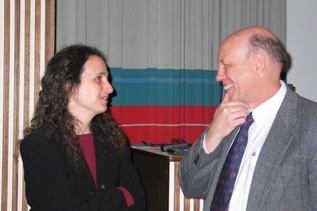 |
Vivian Siegel, Ph.D., speaks with UNMC’s David Bylund, Ph.D. |
Open access journals offer a solution to escalating institutional subscription prices and annual cancellation of library journals, said a former journal editor.
Vivian Siegel, Ph.D., executive director of the Public Library of Science (PLOS) and former editor of Cell, was on campus last month to advocate open access publishing of scientific papers.
“The research paper is often the only tangible product,” she said, noting public research should be made available to as many people as possible. “Databases of scientific information accelerate the progress of science.”
Unlike subscription-based publishing, open access publishing has several advantages:
- Free and unrestricted online access to the research literature and databases;
- Users are licensed to download, print, copy, redistribute and use the literature;
- The author retains the right to be acknowledged; and
- Papers are deposited in a public database that allows sophisticated searches.
PLOS is working to transform the current publishing regime, Dr. Siegel said, by publishing high quality, open access journals and collaborating with other stake holders to advocate for open access. PLOS Biology was launched online Oct. 13, 2003, with more than 500,000 visitors in the first 12 hours, Dr. Siegel said. In the near future, PLOS intends to launch additional field specific journals.
There are several advantages to online publishing, she said. In a digital era, it costs “pennies” to access any individual article, Dr. Siegel said. Instead, she said, society has determined that journals add value to the scientific literature so commercial publishers get paid for the work by being given ownership of the paper and being allowed to decide how much to charge for access and must be asked for permission for any reuse of the paper.
Transferring ownership doesn’t make sense when an alternative is feasible, she said. Most journals have decided not to contribute their content to PubMed Central or any other public repository, limiting the ability of scientists to search the literature. Journals are essentially monopolies, she said, that can limit subscriptions to only a few hundred libraries, as long as they make a profit.
Two of the largest private funding agencies of biomedical research, the Howard Hughes Medical Institute and Wellcome Trust, are beginning to voice support for open access publishing, Dr. Siegel said.
“But, ultimately, the content is in the hands of the scientific community,” Dr. Siegel said. “If the scientific community decided that they would have their own journal and submit the best articles there then that journal would become a destination journal.”
“You’re not a powerless observer,” Dr. Siegel said. “The future really is in your hands.”
Nancy Woelfl, Ph.D., director of the UNMC McGoogan Library of Medicine and one of three UNMC panelists to respond to Dr. Siegel’s presentation, hopes the open access model will succeed because it balances the rights of authors, distributors and users. “The current system grossly shortchanges authors and users,” she said. “Scientific, technical and medical publishing has become a commodity in an unregulated market.”
Consolidation of the publishing market has driven rapid price increases, she said, as has bundling (all or nothing deals); site licensing; tiered pricing; copyright royalties on interlibrary loans (pay for academic reuse). “Publishers are not charging based on product costs, but on what libraries and users are willing to pay,” Dr. Woelfl said.
Libraries have raided book budgets to avoid cancellations of journals, she said. In 2002, McGoogan Library bought only 800 of the 2,500 suitable scientific books they should have purchased, she said. “There’s been a dramatic erosion of the purchasing power,” she said.
In 1992, the McGoogan Library of Medicine received $20,000 a year through Nebraska Research Initiative funds and purchased 27 different journal subscriptions with that money. Today, because of price increases, the library can afford only three of those 27 titles. “It’s sobering,” Dr. Woelfl said.
She praised Jim Turpen, Ph.D., professor of genetics, cell biology and anatomy at UNMC, for contributing funds from the BRIN (Biomedical Research Infrastructure Network) grant to license Cell and Nature journals online.
If open access publishing succeeds, the role of libraries will remain, although the tools will change, Dr. Woelfl said. “We are knowledge navigators,” she said.
Peter Coccia, M.D., chairman of the UNMC College of Medicine Promotion & Tenure Committee, said the impact of open access publishing on promotion and tenure is not yet known.
Generally, promotion and tenure committees require evidence of high quality peer reviewed publications. “That leaves an incredible amount of latitude,” he said, in terms of the types of acceptable publications.
Open access journals likely will be considered equal to subscription-based journals, Dr. Coccia said, if the promotion and tenure committee is convinced the material has been adequately and critically peer reviewed. “The real ‘I don’t know’ is the permanency of the place the article will be published and its availability to the scientific community,” he said.
David Bylund, Ph.D., associate editor of the Journal of Pharmacology & Experimental Therapeutics and professor of pharmacology at UNMC, said it’s important to distinguish between profit and not-for-profit publishers.
“Ultimately scientists will decide based on where they choose to submit their articles,” Dr. Bylund said. “Ultimately that’s where the power is.”